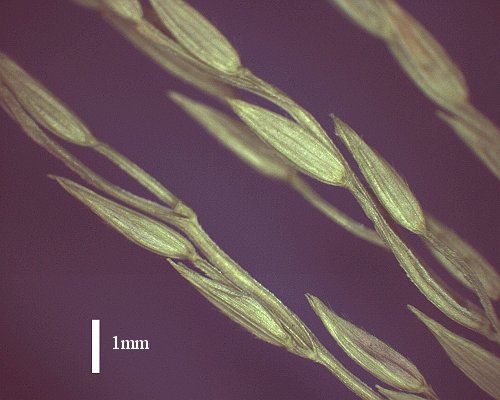Digitaria aequiglumis* (Hack. & Arech.) Parodi. Revista Fac. Agron. Veterin. 4: 47 (1922).
Classification. (GPWG 2001) : Subfamily Panicoideae. Paniceae.
Basionym and/or
Replacement Name: Panicum
aequiglume Hack. & Arechav., Anales Mus. Nac. Montevideo 1: 113 (1894).
Type of Basionym or
Protologue Information: HT: J. Arechavaleta s.n. (Herb. Hackel 22880), Uruguay: Campos del Uruguay (W; IT: BAA (fragm.
ex W), MVFA (fragm. ex W), SI (fragm. ex W & photo)).
Key references
(books and floras): [2002] D.Sharp & B.K.Simon, AusGrass, Grasses of
Australia,
[2008] S.W.L.Jacobs, R.D.B.Walley & D.J.B.Wheeler, Grasses of New South
Wales (213).
Illustrations:
[2008] S.W.L.Jacobs, R.D.B.Whalley & D.J.B.Wheeler, Grasses of New South
Wales, 4th edn (213).
Habit. Annual.
Rhizomes absent. Stolons present. Culms erect or geniculately ascending or
decumbent, 20–50 cm tall, 2–5 -noded. Mid-culm internodes glabrous. Mid-culm
nodes glabrous. Lateral branches sparsely branched or branched. Leaf-sheaths
glabrous on surface. Leaf-sheath auricles present. Ligule an eciliate membrane,
1–2 mm long, truncate. Leaf-blades flat, 2.5–11.5 cm long, 2–5 mm wide.
Leaf-blade surface smooth, glabrous or indumented.
Inflorescence.
Inflorescence digitate, with racemose branches. Racemes 3–5, erect or
ascending, flexuous, 5–8 cm long. Central inflorescence axis 0–2.5 cm long.
Spikelets.
Spikelets pedicelled, 2 in the cluster. Fertile spikelets 2-flowered, the lower
floret barren (rarely male), the upper fertile, comprising 1 basal sterile
florets, comprising 1 fertile floret(s), without rachilla extension,
lanceolate, dorsally compressed, 3–3.7 mm long.
Glumes. Glumes
thinner than fertile lemma. Upper glume elliptic, 3–3.7 mm long, membranous,
without keels, 5–7 -nerved. Upper glume surface indumented. Florets.
Basal sterile florets 1, barren, without significant palea. Lemma of lower
sterile floret 100 % of length of spikelet, membranous, 5–7 -nerved.
Fertile lemma 2.5–3.5
mm long, without keel. Lodicules present.
Continental
Distribution: Australasia and South America.
Australian
Distribution: South Australia, New South Wales.
South Australia: Southern Lofty. New South Wales: North
Coast, Central Coast.
Notes. A
species of sandy disturbed sites and swampy areas in and about the Sydney area; introduced
on the Royal Adelaide Golf Club. Flowers Jan.-Apr.




